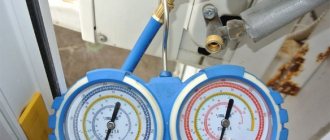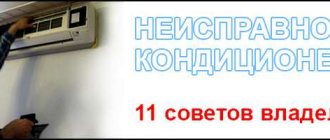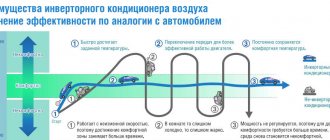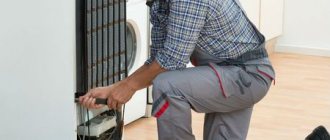The cold weather is coming, but you haven’t decided how to heat your home yet? Using an air conditioner for these purposes is very economical and tempting, but you don’t want to risk its performance, right? We will help you figure out whether it is possible to use an air conditioner for heating in frosty conditions, why and in what cases this can be dangerous for the equipment.
We will also tell you what to do so that you can use the air conditioner longer, at lower temperatures. Let's look at how practical and effective this application is. For complete clarity, we will show all the important points in photos and diagrams, and at the end of the article you will find educational videos on the topic.
Why does the split system heat up?
To understand what can go wrong when you turn on the air conditioner in cold weather, you first need to understand what happens during normal operation of the heating system.
Unlike portable heaters of any type, a split system does not produce heat from the energy consumed, but only transports it from the street to the house or vice versa, depending on the mode. Does it sound unrealistic to take heat outside when the temperature is below zero? This is only at first glance.
The main components of any split system are a compressor, a radiator with a fan in each unit and a freon pipeline connecting them. The refrigerant is the main magician in this kit: it is thanks to its physical properties that it becomes possible to obtain heat in the cold and coolness in the heat.
When operating for heating, the indoor and outdoor units of the air conditioner change roles. Typically, the freon flow is redirected through a four-way valve
The path of freon in air conditioners used in winter for heating at low temperatures looks like this:
- Cooled liquid refrigerant is supplied from the radiator of the indoor unit.
- When it gets into the outdoor unit, it heats up and evaporates, because the boiling point of the refrigerant is -40 or -510C, and it’s warmer outside even in winter. After passing through the street radiator, the temperature of the freon rises, that is, it receives thermal energy.
- The resulting energy is low-potential and therefore cannot be immediately transferred to the air in the room. The compressor compresses the gaseous refrigerant, and its temperature rises to 70 - 900C. In this state, freon is supplied to the indoor unit.
- Passing through the radiator of the indoor unit, blown by a fan, the refrigerant gives off heat to the room air, and itself cools and condenses into liquid. The circle is closed, everything is repeated from the beginning.
Thanks to this principle of operation, split systems are also classified as heat pumps, because they transport and pump heat from the street to the room or vice versa in the same way.
When freon evaporates, condensation settles on the tubes - moisture from the air, which instantly freezes. To ensure that such ice build-ups melt and do not interfere with operation, most air conditioners periodically switch to defrost mode for 5–15 minutes.
To operate, electricity is needed for the pump itself - the compressor, as well as two fans. Together they consume 3–7 times less energy than the system produces, which means that heating with an air conditioner is 3–7 times more economical than with an electric and gas convector, infrared stove or other heater.
Why is frost dangerous for an air conditioner?
The operating principle of an air conditioner is quite simple, but changing conditions at any stage can lead to serious damage.
Firstly, starting a cold compressor is dangerous. The oil in it thickens at low temperatures, and therefore the unit operates under increased load.
In addition, without lubrication, the friction of metal parts produces chips that clog and damage the system. Therefore, even a new compressor installed to replace a broken one can quickly fail even with correct operation.
Secondly, the freon in the external radiator may not have time to evaporate. The activity of heat exchange depends on the temperature difference. Therefore, with a slight plus outside, freon, warming up from -400C, will absorb a lot of thermal energy.
If it is -300C outside, then the refrigerant may not have time to warm up even to the boiling point. The result is liquid freon entering the compressor and its inevitable breakdown due to water hammer.
The third danger is condensate freezing and icing..
Remember, when working for heating, the split system blocks change roles, so condensation forms on the radiator that is outside
An ice shell on the outdoor unit interferes with heat transfer and can interfere with the fan, which increases the load on all parts of the system. Automatic defrosting is designed to solve this problem, but the water draining from a heated radiator often immediately freezes in the pan. When the ice layer reaches a certain thickness, the fan blades freeze into it, and the air conditioner stops working.
Condensation in the drain pipe can also freeze at the point of exit to the street - if the air conditioner is working on cooling. This may be necessary in winter in server rooms or in the defrosting mode mentioned above. Such an ice plug prevents further drainage of condensate, and it begins to ooze down the wall, provokes the development of mold in the indoor unit, and can damage it.
Even cooling work in winter can cause problems. In this case, the air conditioner takes too much cold from the street, and the condensation on the indoor unit turns into frost and ice. Naturally, this is also detrimental to the equipment. In addition, the problem of cold start of the compressor remains relevant.
What kind of air conditioners can be used for heating?
When buying a split system, you should look for the word “reversible” in the description: it indicates the ability of the device to change the direction of freon flow and work for heating.
The heating function is present in most modern systems; only the temperature at which it is allowed to be used differs. Indicated by the sun symbol or the word Heat
After the problems described, you may get the impression that the heating function in air conditioners is useless and dangerous for the device, but this is not the case. Although the split system will not save you in severe frosts, it will help create a comfortable microclimate in the off-season, when the central heating is turned off and it’s cold outside, or in a temperate climate.
The lower temperature limit at which the split system can be turned on for heating depends on the model - it is indicated in the instructions.
There are certain patterns in the distribution of these temperatures:
- Air conditioners with a linear control type can usually only be turned on down to -50C, since the compressor is constantly turned off and has time to cool down before restarting.
- Inverter models usually operate down to -150C, but some specialized devices are effective down to -20 and even -300C.
- It is sometimes possible to expand the range of operating temperatures declared by the manufacturer by installing a winter kit - we’ll talk about this in more detail later.
- Monoblock air conditioners with a heating function do not depend on the outside temperature, but they are no different in terms of efficiency. In winter they work like a regular convector, with an efficiency of slightly less than 1.
- Systems with R22 refrigerant are less efficient and resistant to low temperatures than those filled with R410A or R32 freon.
It is worth noting that even those models that operate smoothly at low temperatures significantly reduce the efficiency and economy of heating when it gets cold outside.
You cannot simply replace the R22 freon in the air conditioner with a more efficient and modern one - its operating pressure is half as low, and the system parts are not designed for more
Given operating temperature limitations and inconsistent performance, air conditioning cannot be the primary heating appliance for homes in northern regions.
Minimum temperature
At what temperature can the air conditioner be turned on for heating? – there is no clear answer to this question. It all depends on the model and manufacturer. Some models can operate for heating at -10, and some only at +5.
Inverter air conditioners have a lower minimum operating temperature. than non-inverter ones. Below is a table of minimum temperatures for the most popular air conditioner models (we replaced the model power with the ** symbol):
| Air conditioner model | Minimum temperature for heating operation |
| Cooper&Hunter CH-S**FTXLA | -25 |
| Toshiba RAS-**U2KH3S-EE / RAS-**U2AH3S-EE | -5 / -10 |
| Mitsubishi Electric MUZ-FH**VE | -15 / -16 |
| Panasonis CS-HE**QKD/CU-HE**QKD | -15 / -16 |
| Midea MSR-**ARDN1 | 0 |
| DAIKIN FTXB20/RXB20 | -15 |
Differences in the design of frost-resistant air conditioners
Why can one air conditioner be turned on at 30 degrees below zero, while it is undesirable to start others at -50C? The answer is simple: structural features and configuration. The cost of a split system is not always directly proportional to its capabilities, and therefore it is useful to know what effective design solutions exist.
To understand whether it is possible to turn on a particular air conditioner for heating in winter, or whether this is dangerous for the device, pay attention to such details.
Firstly, a low temperature kit should be built in from the factory to prevent cold starts of the compressor and condensate freezing.
As we have already mentioned, inverter models are preferable in winter, since their compressor does not stop when the set temperature in the room is reached, but only slows down. This means that it will not cool down every time and start up with an overload, and it is also more profitable in terms of energy consumption.
The heat exchanger of the outdoor unit can be enlarged so that the freon inside has time to completely evaporate and absorb maximum heat from the air before entering the compressor.
The large area of the heat exchanger allows the split system to operate efficiently even with a small difference between the boiling temperatures of the refrigerant and the air outside
There are also double-circuit heat exchangers in which the performance is regulated by connecting an additional freon circulation circuit. The external unit and heat exchanger may include additional casings and heat accumulators to use the energy generated by the operating equipment.
A high-power compressor compresses the gas more strongly, heating it to higher temperatures. In industrial models, there are also scroll compressors that are not afraid of the ingress of liquid freon.
The refrigerant itself may have different properties. Cheap and widespread R-22 evaporates at -400C, while being able to absorb heat of 233 kJ/kg. For comparison, the newest R-32 evaporates at -51.70C, and is capable of retaining heat up to 390 kJ/kg.
This means that under the same conditions, the second one will heat up faster and more efficiently in the heat exchanger, and the air conditioner or split system will operate with lower energy consumption and higher efficiency.
The type of oil that lubricates the compressor also depends on the type of refrigerant. R-22 works with mineral oil, which maintains an acceptable viscosity down to -50C, and R410A and R32 - with synthetic oil, which is stable down to -70C. It would seem that the difference is small, but taken together with other factors it is significant.
Mitsubishi Zubadan is the most famous series of heat pumps that operate in winter at temperatures down to -250C. They cost 3–5 times more than split systems, which can heat only in slight frosts
The more of the listed upgrades the air conditioner has, the lower the temperature it can operate at. However, for many inverter models you may not even know the maximum permissible temperature: the electronic control simply will not start the system if it is too cold outside.
Heating efficiency
The split system may not always be able to operate at full capacity in cold weather. For example, the specification states that it can operate down to -20. This does not mean that the air conditioner will warm the air to +24.
As a rule, at a minimum temperature the air warms up no higher than +16...+18 °C. The colder it is outside, the worse the air conditioner works.
Each air conditioner has a COP (Coefficient of performance). This is analogous to efficiency. The higher it is, the more economically the equipment operates. For example, at COP 3, for every 1 kW of electricity you will receive 3 kW of heat.
The greater the difference in temperature outside and in the apartment, the lower the COP and the worse the air conditioner works for heating.
Winter air conditioner kit
Recently, more and more often you can find proposals for equipping an air conditioner with a winter kit. Sellers of this equipment assure that its installation will make the air conditioner an effective heater throughout the winter, even in frosty weather. Whether this is so - we will figure it out.
Components of a winter work kit
A low-temperature kit, as a rule, includes 3 components: a heating pan, a compressor crankcase and a fan speed controller. Sometimes there is also a temperature sensor and a control board - separate for each component or common to all.
Heating the pan is necessary to prevent the condensate draining from the radiator from freezing when the defrost mode is turned on.
The crankcase heater is a wire or plate that surrounds the compressor in the place where oil accumulates.
It is advisable to turn on the compressor heating before starting the air conditioner so that the oil has time to warm up. In practice, heating often occurs either only during operation or only during idle time. Only the second option will ensure safety for the compressor, but it is less profitable due to increased energy consumption.
Thanks to crankcase heating, you can avoid cold starts and operation of the compressor when the lubricant has thickened in the cold, which means increased load during startup and wear of moving parts
Adjusting the fan speed determines the activity of heat exchange between freon and the external environment: the stronger the air flow, the more heat is transferred. When working for heating, this is not critically important, because maximum heat transfer is needed, and high fan speed is set from the factory.
It’s another matter if the air conditioner operates for cooling at temperatures below +14 – +180 allowed by the manufacturer. Then the freon can give off too much heat, and the indoor unit will begin to freeze: it will become covered with frost and ice, and the condensate will freeze. To prevent this from happening, the fan is slowed down.
Is it advisable to install a winter kit?
After installing a low-temperature kit, the owner may have a question: is it now possible to heat the room with an air conditioner at low outside temperatures? The answer is yes, you can, it is now safe for the air conditioner. The exception is unqualified installation or home-made equipment.
If there is dripping from the roof on the air conditioner and therefore huge icicles form, a winter kit will not help - you need a protective visor
Is it effective? Air conditioning heating is valued for its efficiency: its efficiency can reach 3 – 5 and even 7, depending on the model. This is achieved by the fact that the split system is the only heater that does not produce heat. The compressor and fans require much less energy to operate than the system can move into the home.
The declared efficiency, or, as the manufacturers write, COP, is relevant when operating for heating at +70 outside. As it gets colder, the temperature difference between air and freon decreases, which means heat exchange worsens and the efficiency of the air conditioner decreases.
At temperatures below -150C, the efficiency of the air conditioner decreases to approximately 1%, that is, for every kilowatt of electricity consumed, only 1 kW of heat can be obtained. Conventional convectors or infrared heaters, which are cheaper and do not depend on the outside temperature, also have such indicators.
Of course, these calculations are approximate; the result greatly depends on the model of the air conditioner, the low-temperature set, and even the connection diagram of the second one. But the fact is that the lower the temperature outside, the less effective and economical heating with a split system is.
Considering that the cost of a good winter kit for turning on heating with an air conditioner with installation can be 40 - 150% of the cost of the air conditioner, and it will work effectively only down to -150C, the feasibility of the purchase is very controversial.
When the air conditioner operates for cooling in winter without a low-temperature set, frost and an ice crust forms on the indoor unit
It's another matter if you need to cool the room in winter. For example, for a room with equipment. Then the lower limit of permissible temperatures drops from +16 declared by the manufacturer to severe frosts, and the efficiency of the air conditioner will not decrease.
Installation and connection of the winter kit
As we already mentioned, professional installation of a low-temperature kit is not cheap. Not every owner of a split system is ready to pay 5,000 rubles or more for the opportunity to turn on the air conditioner for heating at a temperature 10 - 15 degrees lower than stated. If you're not prepared for that kind of expense, you might be interested in installing a winter kit yourself.
Let us remind you that to operate in winter, the air conditioner requires heating of the sump, the compressor crankcase and the RDK unit - a condensation pressure regulator that controls the fan speed. You can buy a ready-made kit and install it yourself.
Then you will be freed from the difficulties of choosing and searching for components, and will also save money on installation, but you will probably lose the warranty on the split system. Naturally, self-installation means additional hassle.
The most economical option is to buy 2 pieces of heating cable, preferably self-regulating, and connect them yourself. Controlling the fan speed when working for heating can be neglected; we explained why above.
When choosing a low-temperature kit, pay attention to what power air conditioners it is intended for. There are 2 types of sets, up to 12 BTU and for more powerful systems
To heat the tray, you will need a piece of heating cable about 3 m long. They lay it around the radiator both from the outside and from the inside, as well as along the entire tray in a snake. You can connect the power supply to the outdoor unit, like the factory heating, to the main phase - then the cable will always heat as long as the air conditioner is plugged in, even when idle.
Alternative options are to bring a separate cable with a plug to the outlet and turn it on manually, connect it to the network through a thermostat on the street or through a timer.
To warm up the oil in the compressor, wrap a piece of heating cable around it at the bottom. The electrical connection is carried out together with the heating of the pan.
If you purchased an RDK, you need to find a free space for it in the control compartment, above the compressor, and secure it with self-tapping screws. The electrical connection differs for different models and is always described in detail in the instructions. For correct operation, the sensor included in the kit is attached to the middle loop of the radiator, coated with thermal paste, and wrapped with heat-insulating material.
Heat pump or air conditioner?
Did you know? What is the principle of operation of an air-to-air heat pump that is no different from an air conditioner? Their main difference is in characteristics and price.
Modern air source heat pumps can operate at temperatures below -35. For an air conditioner, the minimum temperature (for some models) is -28. According to the installation principle, they do not differ, the only difference is in price and maintenance costs.
If you decide to heat your home with air conditioning, and temperatures in your area can drop below -20, consider purchasing a heat pump. It has another important advantage - the COP coefficient of the heat pump is much higher. Than the air conditioner.










